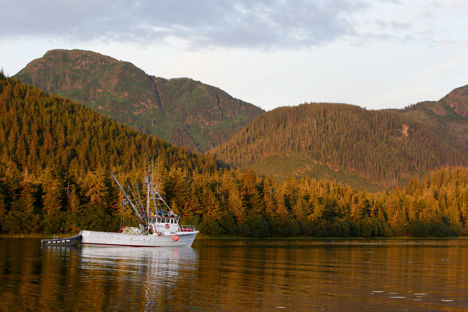
Tide to taste: why wild Alaska salmon tastes so fantastic
The lifestyle and habitat of the salmon we choose can completely elevate our recipes – particularly when it’s wild-caught. We sought to find out more.
Tide to taste: why wild Alaska salmon tastes so fantastic
The lifestyle and habitat of the salmon we choose can completely elevate our recipes – particularly when it’s wild-caught. We sought to find out more.
Whether we’re curing it, pan-searing as a fillet or transforming it into a delicious terrine, salmon is a menu staple for most home cooks, versatile enough to star in both simple post-work suppers and dinner party feasts. And when it comes to choosing and cooking our salmon, we know that how it lived and was caught can enormously improve our finished dishes – something that LEAP Wild Fish also understands well. We’ve delved into the story behind its wild-caught sockeye salmon, exploring why the fish delivers when it comes to taste, texture, and sustainability, elevating recipes. Being able to swim freely and eat a natural diet of shellfish and crustaceans creates a fantastic fish when it comes to both a rich flavour, colour, and a succulent texture.
Most of us will have spotted farmed salmon in the supermarket. It’s pale pink (almost orange), and generally has a mild flavour. Next to it, wild sockeye salmon visibly stands out. Not only is wild salmon a vibrant, crimson colour, but it also delivers a much more intense and robust flavour. Its ability to swim thousands of miles uninterrupted results in a lean and succulent texture that is generally less fatty than that of farmed salmon (this also contributes to its beautiful flavour). All of these are attributes which shine through in dishes where salmon is given a starring role.
The main factor which determines the unrivalled taste of wild salmon is its diet. As the adage goes, we are what we eat. Though we might usually apply that logic to ourselves, it also holds true when it comes to wild salmon, the diet of which has a pivotal role in shaping its flavour profile and nutrient content. While farm-raised salmon often eat a diet based around corn or soy, wild salmon swims through the cold, crystal waters of the North Pacific, feasting on a rich, natural diet of shellfish and marine organisms. This – thanks to the pigment these organisms contain – give salmon its amazing, vibrant colour. Notes of that diet then come through into the flavour of the fish when it’s cooked, giving a fantastic taste, while ensuring that wild sockeye salmon is a brilliant source of protein, omega-3 and vitamin D, meaning every bite is packed with nutrients. While we’re sure all of us aim to use the best ingredients we can in all our home cooking, we know there are certain dishes where that becomes even more important. After all, recipes which allow the flavour of certain ingredients to shine call for the finest of quality – this smoked wild Alaska salmon tartare with potato rosti by Michael Bremner, for example, puts wild salmon centre stage.
LEAP’s sockeye salmon is wild-caught in the North Pacific waters of Alaska and every fish can be traced right back to the boat which caught it. Responsible fishing is at the heart of what LEAP does; it works closely with fisheries and suppliers it trusts to make sure its supply chains are constantly improving and always choose fishing methods that have the least possible impact on the marine environment. LEAP also works closely with the Marine Stewardship Council (MSC), an international non-profit organisation which is committed to making sure our oceans are teeming with life, and all LEAP salmon is MSC-certified. This is marked on the pack by a blue eco-label which ensures effective fisheries management and the protection of fish stocks and their environment. Above all, it knows overfishing poses a considerable threat to species, marine ecosystems, and the supply of seafood for future generations. That's why LEAP believes its duty is to drive change in the fishing industry.
Ultimately, when every step from sea to table is considered so thoroughly, it’s no wonder it results in exceptional quality. In Alaska, for example, fishing is heavily regulated and rules around sustainable fishing are so important they are even written into its constitution, while its wild fisheries are Responsible Fisheries Management-accredited, its own certification programme. It’s no coincidence its waters, and those of similarly wild fisheries, are home to some of the world’s most exceptional seafood.
Skill, our kitchen tools, trusted recipes, and a dose of luck all have a part to play in our culinary success, but most chefs will tell us that we are only as good as the ingredients we use. After all, there is a reason we can create stunning dishes without complicated processes. We might already be convinced of the environmental benefits of buying wild seafood, but there are few better incentives to do so than knowing it will also transform our cooking. Helpful for the planet, and guaranteed to pack a flavour punch? We’re on board.


